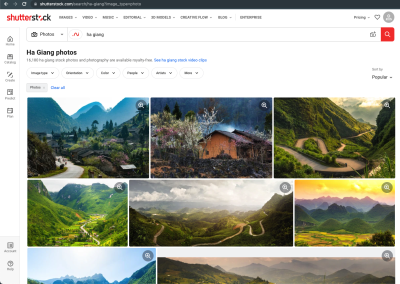Looking to bring your creative ideas to life with a custom touch? Shutterstock isn’t just about stock photos and illustrations — it’s also a vibrant community of talented artists ready to collaborate on unique projects. Connecting with the right artist can seem daunting at first, but with a little guidance, you can easily find someone whose style and expertise match your vision. Whether you need a custom illustration, a logo, or a special piece of artwork, Shutterstock provides a platform where you can reach out directly and start a conversation. Let’s walk through how to make that connection smoothly and confidently.
Steps to Find and Select the Right Artist for Your Project

Finding the perfect artist for your project might feel overwhelming, but breaking it down into clear steps makes it manageable. Here’s a simple guide to help you navigate the process:
- Explore the Shutterstock Artist Community: Start by browsing the Shutterstock Contributor or Artist sections. Use filters such as style, specialization, or portfolio keywords to narrow down your options.
- Review Portfolios Carefully: Look at the artist’s previous work to see if their style aligns with your vision. Pay attention to their versatility, creativity, and consistency.
- Check Artist Profiles: Many artists include detailed profiles with their skills, experience, and preferred project types. Some may also showcase client testimonials or reviews.
- Identify Potential Matches: Shortlist a few artists whose work resonates with your needs. Consider factors like their communication style, responsiveness, and whether they’ve worked on similar projects before.
- Reach Out with a Clear Message: When contacting an artist, be specific about your project. Include details like:
- The type of artwork you need
- Your deadline
- Your budget range
- Discuss and Negotiate: Engage in a conversation about the scope, timeline, and pricing. Be open to suggestions, and don’t hesitate to ask for samples or concepts if needed.
- Review the Agreement: Once you find an artist who fits your project, clarify the terms, rights, and deliverables before moving forward. A clear agreement ensures a smooth collaboration.
By following these steps, you’ll increase your chances of connecting with an artist who not only understands your vision but also delivers work that exceeds expectations. Remember, good communication and clarity are key to a successful collaboration on Shutterstock!
How to Reach Out to an Artist on Shutterstock Effectively

Connecting with an artist on Shutterstock might seem straightforward, but doing it effectively can make all the difference in getting the results you want. Think of it like emailing a new friend—you want to be clear, polite, and respectful of their time. So, how do you do that in a way that’ll catch their attention and encourage a positive response?
First, start with a well-crafted message. When you send your initial contact, make sure to introduce yourself briefly. Mention why you’re reaching out—whether it’s to commission custom artwork, ask about licensing, or discuss a project. Artists appreciate clarity and honesty, so be upfront about your needs.
Next, personalize your message. Instead of a generic template, reference specific pieces of their work that you admire. For example, “I really love your illustration of cityscapes; it perfectly captures the vibrant energy I want for my project.” This shows you’ve taken the time to review their portfolio and genuinely appreciate their style.
Keep your message concise but informative. Include essential details like:
- The scope of the project
- Desired style or theme
- Timeline or deadlines
- Budget range (if appropriate)
Be respectful of their time—artists are often busy, so avoid overwhelming them with too much information upfront. Instead, express your interest and ask if they’re available for a project like yours.
Another tip is to be polite and professional. Use proper greetings and thank them for considering your request. Remember, building a good rapport can lead to better collaboration and a smoother process overall.
Lastly, be patient. Artists might take some time to respond, especially if they’re working on multiple projects. If you don’t hear back within a week or two, it’s okay to send a friendly follow-up—just keep it courteous and light.
Tips for Communicating Your Custom Work Requirements
Once you’ve made initial contact and the artist has shown interest, it’s crucial to communicate your project requirements clearly. Think of this step as setting the foundation for a successful collaboration—you want the artist to understand exactly what you’re envisioning without any confusion.
Start by preparing a detailed brief. This doesn’t mean you need to write a novel, but include the key points to help the artist grasp your expectations. Here’s what to consider:
- Purpose of the artwork: Is it for a website, print, merchandise, or social media?
- Style preferences: Do you want something realistic, abstract, minimalist, or vibrant? If possible, share sample images or mood boards.
- Color schemes: Are there specific colors you want or want to avoid?
- Size and resolution: What dimensions or quality levels are needed?
- Deadline: When do you need the final work?
- Usage rights: Clarify whether you need exclusive rights, commercial use, or personal use.
Be as specific as possible, but also open to the artist’s creative input. Remember, they’re professionals who can offer valuable suggestions based on their expertise.
Communication is a two-way street. Encourage the artist to ask questions and provide feedback throughout the process. Regular updates help ensure everyone stays on the same page and can lead to a better end product.
If you have reference images, sketches, or examples, share them. Visual aids are incredibly helpful in conveying your idea and reducing misunderstandings.
Finally, discuss revisions upfront. Clarify how many rounds of revisions are included and how additional changes might be handled. This transparency helps avoid surprises later on and keeps the project running smoothly.
By being clear, respectful, and collaborative in your communication, you’ll set the stage for a successful partnership with the artist—resulting in artwork that truly matches your vision and needs.
Understanding Shutterstock’s Messaging System and Policies
When it comes to collaborating with artists on Shutterstock, getting familiar with their messaging system is key. Shutterstock’s platform isn’t just about browsing and purchasing images; it also offers a built-in messaging feature that helps you communicate directly with artists. This is a great way to discuss your project details, ask questions, or request custom work.
First off, how do you access this messaging system? It’s simple! Once you find an artist whose style you like, you can go to their profile and click on the “Contact” or “Message” button. This opens a secure chat window where you can start a conversation.
Important points to keep in mind:
- Respect the platform’s policies: Shutterstock has strict rules about communication. All negotiations and project details should stay within their messaging system to ensure security and compliance.
- Be clear and concise: When reaching out, explain your idea in a straightforward way. Mention what kind of custom work you need, your deadline, and any specific preferences.
- Follow up professionally: If you don’t hear back immediately, give the artist some time before sending a polite follow-up message. Remember, artists might be busy or working on other projects.
- Respect their boundaries: Not every artist may offer custom work or respond to all inquiries. If they decline or don’t respond, it’s best to respect their decision and move on.
Shutterstock’s policies emphasize respectful and professional communication. They also provide guidelines to prevent spam or harassment, so it’s important to keep your messages courteous and relevant. Remember, the goal is to build a positive relationship that could lead to a successful collaboration.
Lastly, always review any agreements or terms discussed through the messaging system carefully. Once you both agree on the scope of work, it’s good to have everything documented in your conversations. This helps avoid misunderstandings and ensures everyone is on the same page.
Additional Tips for Successful Collaboration with Shutterstock Artists
Collaborating with artists on Shutterstock can be a fantastic experience, especially when you approach it with the right mindset. Here are some helpful tips to make your project smooth, professional, and enjoyable:
1. Be Specific About Your Needs
The more details you provide, the easier it is for the artist to deliver exactly what you’re looking for. Share information about the style, colors, mood, and purpose of the artwork. If you have sketches or reference images, include those too. Clear communication upfront saves time and reduces revisions later.
2. Respect the Artist’s Creative Process
Artists bring their unique style and perspective to each project. Trust their expertise and give them room to interpret your ideas creatively. If you have strong preferences, communicate them politely, but be open to suggestions that might improve the final product.
3. Clarify Licensing and Usage Rights
Before starting the project, make sure you understand the licensing terms. Discuss how you plan to use the artwork—whether for commercial purposes, print, digital use, etc. Having this conversation early helps prevent licensing issues down the line.
4. Set Realistic Deadlines and Budgets
Be transparent about your timeline and budget from the beginning. Artists appreciate knowing your expectations upfront, which helps them plan their workload accordingly. Remember, quality work takes time, so avoid rushing artists for faster delivery if it compromises quality.
5. Maintain Open and Respectful Communication
Keep the lines of communication open throughout the project. Provide constructive feedback and be responsive to questions or updates from the artist. A respectful attitude fosters a positive working relationship that can lead to future collaborations.
6. Be Prepared for Revisions
It’s common to request tweaks or adjustments during the process. Approach revisions with patience and clarity. Clearly specify what changes you want and why, which helps the artist understand your vision better.
7. Show Appreciation
Finally, don’t forget to thank the artist for their work. A simple note of appreciation can go a long way and encourage them to do their best for your project. Building good rapport can lead to more successful projects in the future.
By following these tips, you’ll set the stage for a productive and positive collaboration with Shutterstock artists. Remember, clear communication and mutual respect are the foundations of any successful creative partnership!
Conclusion and Final Advice for Working with Shutterstock Artists
Connecting with Shutterstock artists for custom work can be a seamless experience when approached thoughtfully. Clear communication is key—ensure you articulate your vision, preferred style, and deadlines from the outset. Remember that artists appreciate detailed briefs, which help them deliver exactly what you need. When reaching out, consider the following tips:
- Review the artist’s portfolio to confirm their style aligns with your project.
- Be respectful of their time and expertise—artists are professionals who deserve fair compensation.
- Use the messaging system within Shutterstock to maintain a record of your conversations and agreements.
- Discuss licensing and usage rights upfront to avoid misunderstandings later.
- Provide feedback constructively to foster a positive collaboration.
Additionally, always read the artist’s profile and terms to understand their policies on revisions, pricing, and delivery timelines. Building a good rapport can lead to a successful ongoing relationship and high-quality results. If you follow these guidelines, you’ll find working with Shutterstock artists to be a rewarding experience that enhances your creative projects.
In summary, approach your communication professionally, be transparent about your needs, and respect the artist’s craft. This will ensure a smooth collaboration and help you achieve the custom artwork you envision.


